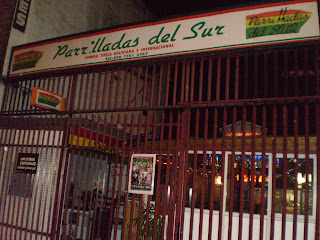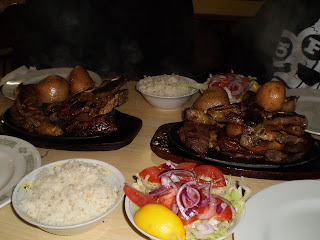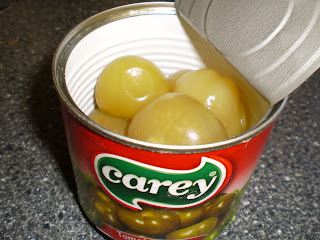
In the interests of fairness I must admit that it's been a year since we went to Lutong Pinoy. Prince Phil's latest gaffe reminded me of what had been a great meal and also how sadly neglected this blog is. Happily I can confirm that it's still open (unlike a number of restaurants I've visited during the course of this blog - not as a result of my posts, no one reads them).
Located in Earl's Court, apparently home to the UK's largest Filipino community, Lutong offers a buffet which was winding up when we arrived at about 9, as well as a menu. Confronted with an extensive list of unfamiliar dishes we asked the hosts to choose us a selection of the Philippine's greatest hits for 10 people. What they brought didn't disappoint. The quantity and quality of the food they produced at a time when I'm sure they were just about to close up (I would have been tempted to give us the buffet leftovers) and for what amounted to under £20 a head with a few beers each, was impressive.
Battle commenced with a starter of deep fried shell on prawns, which were fresh tasting and edible whole like whitebait, and longganisa evidencing the Philippines' Spanish colonial past, similar in appearance and texture to a chorizo, but much sweeter with a taste of garlic and soy sauce.
Highlights of the mains included a firm fleshed deep fried red snapper in a sweet and sour sauce, something in between Cantonese sweet and sour and a Spanish escabeche. A deep fried 'milk fish' which we were told was a particularly Filipino delicacy, so called because of its creamy taste, was served with a spicy dipping sauce and was delicious, although you had to be wary of small bones. Continuing the fish theme, there was a full flavoured dish of stir fried squid (tasting like the ink had been used in the sauce) and an extremely spicy mixed seafood noodles similar to a chow mien.
A particular favourite was the 'kare kare', sadly not photographed, unctuous slow cooked oxtail in a peanut sauce. Sisig, a mighty plate of sizzling, finely chopped pork offal (liver, heart and ear), Filipino black pudding, ginger, onions, plenty of chili and an egg on top, was a treat to behold. The Chicken adobo, another Spanish influenced dish of chicken in a spicy vinegar and soy sauce was also very pleasant.
So I've been a fan of Filipino food for a year now. Flavour wise it seems to incorporate influences from some of my favourite cuisines, most notably Spanish, Chinese, Malaysian and Indonesian. Spanish with the love of fried fish and liberal use of citrus fruits, vinegar and garlic in many of its dishes, Chinese with the use of soy sauce, noodles and ginger and Malaysian/Indonesian with peanut based sauces. The combined taste sensations of sweet, salty, hot and sour present in Filipino cooking make for an exciting and delicious meal.
Lutong Pinoy
10 Kenway Road, Earl's Court, SW5 0RR
Tel: 0207 244 0007






















